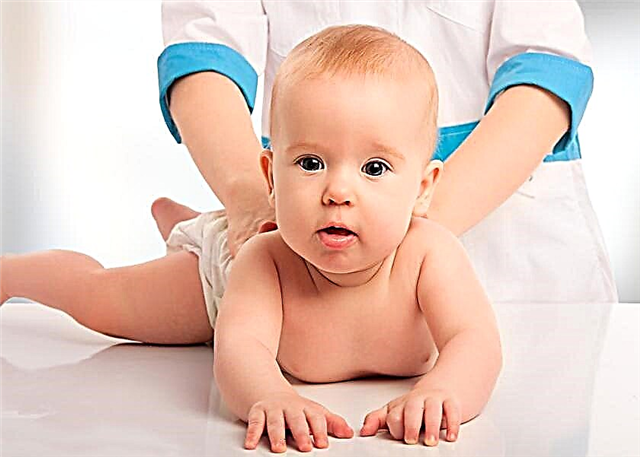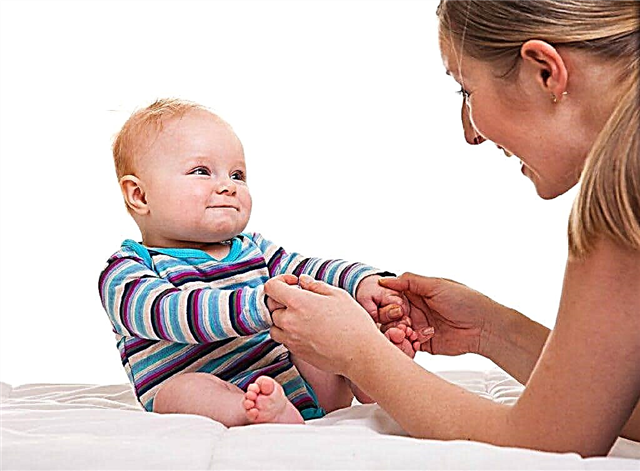Any change in the baby's behavior immediately attracts the attention of the baby's parents. Such manifestations include such a variety of gestures in babies as head shaking. Most often it occurs during sleep or in front of it. Observing this symptom, many parents begin to be very anxious, perceiving it as a reason for an immediate visit to a doctor. However, is it worth worrying? What to do if a small child turns his head from side to side? In what cases should the baby be shown to the doctor, and what is the opinion of the famous pediatrician Yevgeny Komarovsky on this?

Head wagging in a child is usually not a dangerous symptom.
Why does the child shake his head
Monthly babies can already easily turn their head while lying on their side. Gradually, the bones and muscles become stronger, which allows the baby to master new, more complex movements. Over time, he gains the ability to stretch his neck when crawling, he can nod, thus representing the word "yes".
When the baby is 5-6 months old, he suddenly begins to twist his head from side to side. Such movements are usually repeated many times, in some cases children twirl their whole body for 15 minutes in a row. It is not surprising that this behavior scares parents, but more often than not, such manifestations are natural.
The most common reasons a child shakes their head from side to side include:
- An infant's attempt to attract attention to itself.
- The baby is tired and wants to sleep.
- The kid learns and trains new motor skills.
- The child is emotionally uplifted, worried, happy, scared, and so on.
- Examines his own feelings.
- The baby is bored.
- The child is experiencing pain from teething.
To understand which of the reasons caused the strange behavior in the baby in one case or another, it is enough just to observe the baby for a while. Having established the cause, you can try to eliminate it with appropriate actions, for example, put to bed, show attention, give a teether, and so on.
It has been noticed that boys like to turn their heads from side to side and even bang their heads against the crib or wall more often than girls.
Head wagging is typical for babies of different ages: it can start earlier than 5-6 months, while the likelihood of the symptom manifesting remains up to 3 years. According to pediatricians and neurologists, this behavior is usually not a sign of a particular disease and goes away on its own. Head wagging only in very rare cases can be a symptom of pathology and lag in the development of the baby.
On a note. The well-known pediatrician E. Komarovsky considers shaking his head from side to side as one of the varieties of obsessive movements in children.
From this point of view, the doctor calls the main reasons for negative manifestations:
- Severe stress;
- Psychologically unfavorable family environment;
- Significant mistakes in education (excessive severity, lack of attention);
- A sharp change in the environment (moving, the first day in kindergarten, visiting a doctor, a long absence of parents around).
Causes of head shaking in a newborn
This symptom in infants is most often completely harmless and only in some cases is a sign of serious deviations from the norm. The first category of causes includes many different factors that can cause head shaking in a newborn. These include:
- Studies have shown that when the center of balance in the brain is excited, the baby enjoys the process of shaking his head from side to side. In this case, there is no cause for concern.
- Teething. This process causes discomfort and pain in the child. To distract from these sensations, the baby shakes his head.
- Development, strengthening of muscles and bones during the first few months of life. The need to master and train new motor skills.
- Often, head shaking can occur while eating. Therefore, when feeding, the mother must fix the baby's head in her hands. Gradually, the baby acquires the ability to keep it on its own, then the need to fix it during lactation for the mother disappears.
- A common cause of this condition is the child's usual curiosity about the environment.
- Babies can turn their heads if they have a sweaty head. This can occur due to improper temperature conditions in the room or excessive wrapping of the baby. The toddler is sobbing, spinning in bed, as if trying to find a comfortable position.
- The baby may shake his head during the day or night rest, when he observes disturbing dreams. At such moments, children often scream and cry.
- Emotional overexcitement. Such a state prevents the baby from falling asleep, the baby is spinning, trying to relax and calm down.
- Lack of parental attention. In such cases, the child can swing, spin, move his head rhythmically.
Pathological reasons for the child's unusual head-shaking behavior include:
- Colic in the abdomen. Very common in babies. Passes by itself.
- Otitis. Feeling discomfort in the ears, the child shakes his head, trying to get rid of it.
- Headache.
- Rickets. In this case, the baby shakes its head quite often, especially before bedtime.
- Hydrocephalus.
- Autism. This disease is very rare. The baby sways, can tremble all over, shakes his head, whines, cries.
- Epilepsy. The child begins to shake all over, including shaking his head.
On a note. In cases of pathological disorders, in addition to the main symptom (head shaking), the baby also has other alarming manifestations: for example, the baby becomes too capricious. By performing these actions, the baby is trying to distract himself from the unpleasant sensations.

Some of the most common causes of yakation in newborns are muscle development and the training of new motor skills
Age features of head shaking
According to children's doctors, head-shaking in a newborn is a phenomenon that is determined by the specific age of the child. The period during which a similar symptom may occur includes the age from 2-3 months to 3 years.
On a note. The phenomenon of yakation (this is the name of an arbitrary rhythmic swinging of the body or head) does not in any way affect the development of children. Therefore, in most cases like this, there is nothing to worry about.
There are certain age-specific features of this phenomenon.
At 5 months
At this age, shaking the head most often indicates the development of new motor skills by the child. Also, do not exclude fatigue and sleepiness from the list of possible causes.
At 6 months
At six months, babies usually begin to erupt their teeth, which is why the baby can shake its head from side to side. A cheerful mood in a child can also cause such behavior. As practice shows, this kind of entertainment is to the liking of boys aged 6-7 months. At these moments, the kids turn their heads in different directions and even beat it against the sides of the bed. For them, this activity is just a kind of game.
At 7 months
Seven-month-old babies often start shaking their heads, waving their arms and legs because of boredom or in case of lack of parental attention. The likelihood of this symptom increases due to the fact that the baby learns the world around him more actively, therefore it requires even more attention.
At 8 months
At this age, the baby is able to clearly demonstrate his character. In addition, during this period, the baby gets acquainted with complementary foods, the formation of his taste habits and preferences. For these reasons, the phenomenon of yakation at 8 months often turns out to be a manifestation of character - this is how a child shows protest, defends his boundaries. For example, shaking your head may mean that the baby is tired, and for today there is enough work.
At 9 months to a year
Closer to the year, the active development and training of the vestibular apparatus, which is largely responsible for the coordination of movements, takes place. Thanks to its normal operation, the baby does not fall on its side and can move in the direction it needs. Therefore, if a child shakes his head, then perhaps in this way he trains the vestibular apparatus.
Good to know. A well-developed vestibular apparatus provides the baby with comfortable ride on carousels and travel in transport - the child will not feel sick and sick.
How to help a child
When a baby develops signs of yakation, you first need to determine the reason that could cause such behavior. Only by establishing the essence of the phenomenon, you can adequately help the child to cope with the problem (if any):
- If the little one is overexcited, cannot calm down in any way and continues to be actively awake at the wrong time, you need to organize relaxing procedures for him before bedtime;
- Give an anesthetic (when the crumbs are teething, or the ears hurt);
- Pay attention to the newborn, play with him;
- If the alleged cause of yakation is a developmental disorder (autism, rickets), the baby must be shown to the doctor;
- If the child begins to twitch in a dream due to disturbing dreams, you should calm him down with gentle strokes. It will also be helpful to do a light back massage;
- If the baby is sweating, you need to give him a drink, as well as ventilate the room and change clothes.
Important! If the listed actions do not bring a positive result, it is necessary to show the child to a specialist.
Since head-shaking often occurs before or during sleep, the following actions will help eliminate negative manifestations:
- Establishment of a ritual of falling asleep, which must necessarily include bathing in a warm bath.
- Listening to lullabies before bed. Analogs can be an audiobook, "white noise".
- Light massage, stroking the back, head, arms, legs.
- Gymnastics.
- Joint sleep.
- Providing comfortable conditions for sleeping (normal room temperature, fresh air, light comfortable clothes).
- Compliance with baby hygiene.
On a note. A one-year-old child needs training of the vestibular apparatus. In this he will be helped by training on fitball, riding on a swing.

Fitball lessons
Alarming symptoms of deviations
Most often, additional symptoms signal the negative causes of yakation. If we are talking about a disease such as reflex tetraparesis, then the signs in this case are:
- Head-shaking usually occurs in the evenings after a child's emotional stress;
- During yakting, the baby cries out, cries;
- When the seizure is over, the infant exhales. It may also stop breathing for a while.
Krabbe's disease is characterized by head shaking when falling asleep. With this pathology, the baby is overweight, allergic to milk, convulsions. The disease may be accompanied by vomiting, fever. At the same time, the child becomes very whiny.
With a disease such as opticomyelitis, the following symptoms are observed:
- When falling asleep, the child has dizziness;
- Certain areas of the hands and feet are affected;
- Optic neuritis;
- Headaches;
- Disruption of the pelvic organs.
Epilepsy is characterized by the following symptoms:
- Twitching of the limbs during falling asleep;
- Headache;
- Head-shaking worse during sleep;
- The child cries, but at the same time he quickly calms down on his own.
- The number of attacks, as well as the intensity of pain, are determined by the severity of the pathology.
Signs of autism are:
- Lack of gurgling in the child;
- The baby does not focus his gaze;
- Does not pay attention to surrounding objects and phenomena.
The presence of rickets can be determined by the following symptoms:
- Intense sweating during sleep and feeding;
- Restless sleep;
- Itching in the head area;
- Hair loss at the back of the head;
- Decreased muscle tone;
- The baby has a swollen belly;
- Curvature of the limbs;
- General weakness;
- Tearfulness;
- Loss of appetite;
- Development of scoliosis, flat feet;
- Development lag.

Rickets in a baby
Head wagging in a child is most often not an alarming symptom - this behavior is quite natural for babies aged 2 months to 3 years. However, in some cases, it is worth showing the baby to the doctor in order to exclude the likelihood of a dangerous pathology.



